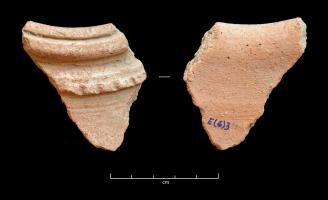
This class is made using several Fabric Groups (mainly 2, 8, 1), which are medium to coarse in texture, with sand temper as noted in vessels of Class 1, which are similar. Indeed, a whitish deposit is also present on many potsherds. Yet on vessels of Class 10 we also see organic temper and imprints visible on both surfaces. Vessels are shaped using a combination of coils and plates, followed by a process of smoothing probably on a slow wheel. Although smoothing traces are clearly noticeable, the general aspect looks coarser and we can feel small irregularities. All pots have been fired in an oxidising atmosphere (7.5YR-5/6 strong brown, 7.5YR-6/6 reddish yellow, 2.5YR-7/6 light red, 5YR-5/6 yellowish red). Two variants have been defined according to the decoration. The first one encompasses plain potsherds, while the second variant incorporates potsherds with a red and/or micaceous slip. Incised (horizontal lines) and impressed (small squares) decoration are noted on the external surface of both variants.
This variant comprises plain potsherds. Vessels with restrictive shapes (pots with in-turned rims and pots with out-turned rims), as well as unrestrictive shapes (bowls) exist. On one rim-sherd, a line of small squares has been impressed at the junction between the shoulder and the rim. For vessel forms, see Lefrancq and Hawkes (2019b, plate 29).

This variant consists of potsherds displaying a micaceous slip, sometimes combined with a red slip (10R-4/6 red, 10R-4/8 red, 10R-5/8 red). Compared with those of variant 1, vessels with restrictive shapes are more numerous. We find shallow bowls and pots with out-turned rim such as jars with neck and everted rim. For vessel forms, see Lefrancq and Hawkes (2019b, plate 30).

Internet Archaeology is an open access journal based in the Department of Archaeology, University of York. Except where otherwise noted, content from this work may be used under the terms of the Creative Commons Attribution 3.0 (CC BY) Unported licence, which permits unrestricted use, distribution, and reproduction in any medium, provided that attribution to the author(s), the title of the work, the Internet Archaeology journal and the relevant URL/DOI are given.
Terms and Conditions | Legal Statements | Privacy Policy | Cookies Policy | Citing Internet Archaeology
Internet Archaeology content is preserved for the long term with the Archaeology Data Service. Help sustain and support open access publication by donating to our Open Access Archaeology Fund.